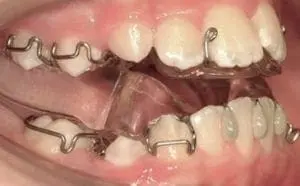Back to Basics 4: Functional appliances and growth
This is the final post from Martyn Cobourne about growth and is on the effect of functional appliances on growth.
Introduction
We discussed craniofacial growth and functional appliances a few weeks before Christmas.
These were my main points;
- The relationship between peak height velocity and growth of the mandible (there is one, although it is not absolute),
- Our ability to quickly and accurately identify peak height velocity in our patients (this is more debatable) and
- Whether treating patients during PHV results in more skeletal growth (the evidence is weak).
What is the evidence on the effect of functional appliances?
Firstly, animal studies have shown evidence of molecular, cellular and dimensional changes accompanied by growth and remodelling of the condyle and glenoid fossa when the mandible is habitually postured forwards with a fixed intra-oral appliance (McNamara et al., 1982; Tang et al., 2004).
Secondly, human clinical studies investigating growth changes related to functional appliance treatment have been carried out for many years. Still, the evidence base remains surprisingly low – composed predominantly of retrospective case-control studies, some prospective controlled studies and only a few well-organised RCTs. Furthermore, these investigations have relied primarily upon cephalometric analysis to measure growth changes. Nevertheless, some good systematic reviews have been published in this area over the last few years. Importantly, current evidence suggests that these appliances’ short-term skeletal changes are minimal (Koretsi et al., 2016; Nucera et al., 2016; Batista et al., 2018).
Effects on growth?
We can consider these under the following main areas.
Maxillary growth.
A very slight inhibitory effect can be achieved, which ranges from -0.28 to -0.61 degrees reduction in SNA angle (= minimal reduction; moderate quality evidence); -0.61 mm anterior maxillary displacement and +0.07 degrees maxillary plane rotation per year;
Mandibular growth.
There are changes of +0.62 degrees increase in SNB angle/year (= minimal increase; low-quality evidence). The most optimistic analysis of functional appliance data has suggested an increase in a mandibular unit length of 2 mm or more, but this figure is based primarily upon retrospective data and analysis of RCTs alone shows less difference (Cozza et al., 2006);
Temporomandibular joint and glenoid fossa.
There is some evidence of very low quality to suggest that minor skeletal and positional remodelling may occur over the short term (less than 1 mm for most dimensions), although the clinical relevance of these changes is unclear (Kyburz et al., 2019);
The overall change in the skeletal relationship.,
A reduction in ANB angle of -1.14 degrees/year (= small decrease; very low-quality evidence) with an overall difference of -2.37 degrees (low-quality evidence); and
Soft tissue effect,
A significant change in the NLA (+2.78 degrees), MLA (+22.60 degrees), H angle (-2.76 degrees) and Z angle (+5.24 degrees) can be achieved.
Combined with the significant dentoalveolar effects, all these changes contribute to the correction of class II dental occlusion, an increase in lower face height and a clockwise rotation of the mandible.
Effects of appliances

When we consider appliances, the twin block seems to be associated with the most skeletal change (Koretsi et al., 2016; Batista et al., 2018), but for all functional appliances, it is the dentoalveolar effects that predominate, and this includes the twin block (Ehsani et al., 2015).
The evidence relating to fixed functional appliances is at high risk of bias. There is little high-quality evidence that fixed functional appliances can significantly influence craniofacial growth (Ishaq et al., 2016). Indeed, dentoalveolar effects also predominate (Zymperdikas et al., 2016). However, when retrospective data is incorporated into the analysis, maximal changes in a mandibular unit length of around 2 mm have also been reported in pubertal patients (Perinetti et al., 2015).
Both fixed and removable functional appliances are effective at correcting class II malocclusion, and whilst the effects on skeletal growth are minimal, removable functional appliances may reduce the ANB angle slightly more than fixed (Pacha et al., 2016; Batista et al., 2018). However, there needs to be more data on the long-term effects of functional appliances.
Final Comments
Overall, the effectiveness of functional appliances is primarily due to early correction of the buccal occlusion and overjet reduction through differential tooth movement, establishing a class I relationship that is maintained whilst normal condylar growth catches up (Johnston, 2005).
Martyn Cobourne:
Faeebook. Evidence-Based Orthodontics
References
Batista, KB, Thiruvenkatachari B, Harrison JE, O’Brien KD, 2018. Orthodontic treatment for prominent upper front teeth (Class II malocclusion) in children and adolescents. Cochrane Database Syst Rev 3, CD003452.
Cozza P, Baccetti T, Franchi L, et al. 2005. Mandibular changes produced by functional appliances in Class II malocclusion: a systematic review. Am J Orthod Dentofacial Orthop 129, 599.e1–599.e12.
Ehsani, S., Nebbe, B., Normando, D., Lagravere, M. O., Flores-Mir, C. 2015. Short-term treatment effects produced by the Twin-block appliance: a systematic review and meta-analysis. Eur J Orthod 37, 170-176.
Ishaq RA, AlHammadi MS, Fayed MM, El-Ezz AA, Mostafa Y. 2016. Fixed functional appliances with multibracket appliances have no skeletal effect on the mandible: A systematic review and meta-analysis. Am J Orthod Dentofacial Orthop 149, 612-624.
Johnston LE. 2005. If wishes were horses: functional appliances and growth modification. Prog Orthod 6, 36–47.
Koretsi V, Zymperdikas VF, Papageorgiou SN, Papadopoulos MA. 2015. Treatment effects of removable functional appliances in patients with Class II malocclusion: a systematic review and meta-analysis. Eur J Orthod 37, 418-434.
Kyburz, KS, Eliades T, Papageorgiou SN. 2019. What effect does functional appliance treatment have on the temporomandibular joint? A systematic review with meta-analysis. Prog Orthod 20, 32.
McNamara JA Jr, Bryan FA. 1987. Long-term mandibular adaptations to protrusive function: an experimental study in Macaca mulatta. Am J Orthod Dentofacial Orthop 92, 98–108.
Nucera R, Lo Giudice A, Rustico L, Matarese G, Papadopoulos MA, Cordasco G. 2016. Effectiveness of orthodontic treatment with functional appliances on maxillary growth in the short term: A systematic review and meta-analysis. Am J Orthod Dentofacial Orthop 149, 600-611 e603.
Pacha MM, Fleming PS, Johal A. 2016. A comparison of the efficacy of fixed versus removable functional appliances in children with Class II malocclusion: A systematic review. Eur J Orthod 38, 621-630.
Perinetti G, Primozic J, Furlani G, Franchi L, Contardo, L. 2015. Treatment effects of fixed functional appliances alone or in combination with multibracket appliances: A systematic review and meta-analysis. Angle Orthod 85, 480-492.
Tang GH, Rabie AB, Hagg U. 2004. Indian hedgehog: a mechanotransduction mediator in condylar cartilage. J Dent Res 83, 434-438.
Zymperdikas VF, Koretsi V, Papageorgiou SN, Papadopoulos MA. 2016. Treatment effects of fixed functional appliances in patients with Class II malocclusion: a systematic review and meta-analysis. Eur J Orthod 38, 113-126.

Excellent evidence based information for our specialty
I really appreciate this post. I find Lyle Johnston’s 2005 comment especially helpful in explaining my clinical observations. However, I still have a problem folding the Herbst research of Pancherz into this summary. His research seemed to be universally respected, but his finding seem to be at odds with most academic opinions. I would love to hear more from Kevin on this.